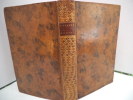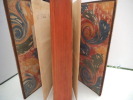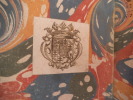HOLBAC(d’) Paul Henri baron d’Holbach
Système Social
ou principes naturels de la morale et de la politique avec un examen de l’influence du gouvernement sur les mœurs3 tomes en un volume in 8 plein cuir fauve raciné pièce de titre chagrin rouge petits fers à la grotesque dorés,faux-titre,titre,VIII,220-176-168 pages tranches rouges filets dors sur coupes Londres 1773 exlibris gravé,un coin très très légèrement émoussé,quelques rousseurs en début de volume sinon très bon état.première édition.sans les 4 pages d'errata
Reference : 2972
"il se fit naturaliser Français, sa maison fut une sorte de salon que fréquentèrent les lettrés et les philosophes de son tems,Diderot,d’Alembert Rousseau… au nom de la science et de la philosophie il entreprit d’abattre la religion et d’édifier une morale nouvelle dans une série d’ouvrages et de pamphlets"
Bookseller's contact details
Charbonnel
M. Sylvain Charbonnel
2, rue du Champ de Mars
55000 Bar le Duc
France
03 29 79 40 63
Payment mode

Sale conditions
Les commandes se font de préférence par e-mail ou par courrier.Tous les livres proposés sont en bon état sauf indications contraires mentionnées dans la description.Les prix sont nets,port en sus à la charge du destinataire.Les envois,après entente concernant les frais de port pour la France s'effectuent dès réception par chèque bancaire,mandat ou virement bancaire.Pour la zone euro par virement bancaire. Me demander mon RIB-IBAN-BIC.Hors Europe Règlement par carte bancaire accepté uniquement par l'intermédiaire de pay pal,les frais sont à la charge de l'acheteur.Les livres voyagent aux risques et périls du destinataire,l'emballage soigné est gratuit.Afin d'éviter tout litige il est expressément conseillé l'envoi en recommandé.Passé un délai d'une dizaine de jours à partir de la date de commande,les ouvrages non réglés seront remis en vente.
5 book(s) with the same title
Système social, ou principes naturels de la morale et de la politique, avec un examen de l'influence du gouvernement sur les moeurs. Par l'Auteur du Systême de la Nature [Mirabaud]. 3 Tomes. - [THE SYSTEM OF NATURE CONTINUED... THE SOCIAL SYSTEM]
London [recte: Amsterdam, M.M. Rey], 1773. 8vo. Bound in one beautiful contemporary full mottled calf binding with five raised bands to richly gilt spine triple gilt line-borders to boards and inner gilt dentelles. Edges of boards with single gilt line. All edges gilt. Corners abit bumped and a bit of overall wear. Inner hinges a bit weak. Internally very fine and clean. All in all a very fine copy indeed. (4), 210176" 167 pp. With all three half-titles, all three title-pages and all three indexes, as well as the introduction.
The rare first edition, first issue (though Tchermerzine mentions an unknown 2-volume-edition form the same year - this edition has never been verified), of one of d'Holbach's most important works, his influential ""social"" and political continuation of his seminal main work ""Systeme de la nature"" - the bible of materialism. D'Holbach (1723-1789), who was raised by a wealthy uncle, whom he inherited, together with his title of Baron, in 1753, maintained one of the most famous salons in Paris. This salon became the social and intellectual centre for the Encyclopédie, which was edited by Diderot and d'Alembert, whom he became closely connected with. D'Holbach himself also contributed decisively to the Encyclopédie, with at least 400 signed contributions, and probably as many unsigned, between 1752 and 1765. The ""Côterie holbachique"" or ""the café of Europe"", as the salon was known, attracted the most brilliant scientists, philosophers, writers and artists of the time (e.g. Diderot, d'Alembert, Helvetius, Voltaire, Hume, Sterne etc, etc.), and it became one of the most important gathering-places for the exchange of philosophical, scientific and political views under the ""ancient régime"". Apart from developing several foundational theories of seminal scientific and philosophical value, D'Holbach became known as one of the most skilled propagators and popularizers of scientific and philosophical ideas, promoting scientific progress and spreading philosophical ideas in a new and highly effective manner. D'Holbach was himself the most audacious philosophe of this circle. During the 1760's he caused numerous anticlerical tracts (written in large, but not entirely, by himself) to be clandestinely printed abroad and illegally circulated in France. His philosophical masterpiece, the ""Système de la nature, ou des lois du monde physique et du monde moral"", a methodological and intransigent affirmation of materialism and atheism, appeared anonymously in 1770"" (D.S.B. VI:468), as did the social and political follow-up of it, the famous ""Systême social"" in 1773. That is to say, Mirabeau whom he had used as the author on the ""System of Nature"" in 1770 is not mentioned in the ""Social System"", on the title-page of which is merely stated ""By the Author of ""Systême de la Nature"". As the theories of d'Holbach's two systematic works were at least as anticlerical and unaccepted as those of his smaller tracts, and on top of that so well presented and so convincing, it would have been dangerous for him to print any of them under his own name, and even under the name of the city or printer. Thus, ""Systême de la Nature"" appeared pseudonomously under the name of the secretary of the Académie Francaise, J.B. Mirabaud, who had died 10 years earlier, and under a fictive place of printing, namely London instead of Amsterdam. ""He could not publish safely under his own name, but had the ingenious idea of using the names of recently dead French authors. Thus, in 1770, his most famous book, ""The System of Nature"", appeared under the name Jean-Baptiste Mirabaud."" (PMM 215), and so the next ""System"" also appeared in the same manner three years later.In his ""Systême de la Nature"", d'Holbach had presented philosophical materialism in an actual system for the first time and had created a work that dared unite the essence of all the essential material of the English and French Enlightenment and incorporate it into a closed materialistic system"" on the basis of a completely materialistic and atheistic foundation, he provided the modern world with a moral and ethic philosophy, the effects of which were tremendous. It is this materialism and atheism that he continues three years later in his next systematic work ""Systême social"", through which politics, morality, and sociology are also incorporated into his system and take the place of the Christianity that he had so fiercely attacked earlier on. In this great work he extends his ethical views to the state and continues the description of human interest from ""Systême de la Nature"" by developing a notion of the just state (by d'Holbach calle ""ethocracy"") that is to secure general welfare. ""Système social (1773"" ""Social System"") placed morality and politics in a utilitarian framework wherein duty became prudent self-interest."" (Encyclopaedia Brittanica). ""Holbach's foundational view is that the most valuable thing a person seeking self-preservation can do is to unite with another person: ""Man is of all beings the most necessary to man"" (Sysème social, 76"" cf. Spinoza's Ethics IVP35C1, C2, and S). Society, when it is just, unites for the common purpose of preservation and the securing of welfare, and society contracts with government for this purpose."" (SEP).As the ""Systême de la Nature"" had been condemned to burning in the year of its publication, so the ""Systême social"" was on the list of books to be confiscated already in 1773, and it was placed on the Index of the Church in August 1775. As the ""Systême de la Nature"", the ""Systême social"" is thus also of great scarcity. Another edition of the work appeared later the same year, in 12mo. Tchermerzine says that ""Il ya une édition, que nous ne connaissons pas, en 2 vol. in-8. C'est sans doute l'originale."" The present edition was reprinted the following year, in 1774.Tschermerzine VI:246" Graesse III:317 Barbier IV:622 (only listing later editions).
Lot 3 volumes- Formation Auxiliaire de santé : Approche de la personne aidée + Connaissance du corps humain + Systeme de santé et systéme social en Suisse - besoins et attentites de la personne, rythmes de vie- la personne agée- la personne porteuse ...
Culture et formation - EduQua - SVEB FSEA MEMBRE. 2021. In-4. Broché. Etat d'usage, Couv. convenable, Dos satisfaisant, Quelques rousseurs. 128 + 93 + 67 PAGES - Nombreuses illustrations couleur, dans et hors texte. . . . Classification Dewey : 370-Education
Approche de la personne aidée : besoins et attentites de la personne, rythmes de vie- la personne agée- la personne porteuse d'un handicap- la personne malade- fin de vie et soins palliatifs- bientraitente / maltraitance + Connaissance du corps humain : la cellule, les tissus, les regions du corps humain, articulations, muscles, appareil digestif, appareil urinaire, appareil genital masculin / feminin systeme nerveux, situations d'urgence, infections nosocomiales, ... + Systeme de santé et systéme social en Suisse : la politique de santé publique, protection sociale, le maintien a domicile des personnes agees, la protection des majeurs vulnerables, les etablissements de santé, ethique et deontologie .... Classification Dewey : 370-Education
Système social, ou principes naturels de la morale et de la politique. Avec un examen de l'influence du gouvernement sur les moeurs.
Londres, sans nom, 1773. 3 volumes in-12 de 318; 252; [4]-239 pages, plein veau moucheté, dos lisses ornés de filets et fleurons dorés, pièces de titre et tomaison bordeaux, tranches marbrées bleues.
Edition parue la même année que l'originale, imprimée par Marc-Michel Rey à Amsterdam. L'objectif du Système social, paru trois ans après le Système de la nature, est d'établir une morale et une politique indépendantes de tout système religieux. La police s'en préoccupa rapidement et le saisit dès juin 1773; il fut mis à l'index en 1775 et connut à nouveau les rigueurs policières en 1822. Bel exemplaire malgré de rares rousseurs et un léger halo en marge de quelques feuillets au deuxième volume; tampon Roland Couvreu au bas de chacune des pages de titre. Le feuillet de tables des matières du second volume est relié au début, au lieu d'être à la fin. Vercruysse : Bibliographie descriptive des écrits du baron d’Holbach-A6; INED 2290.
Système social ou Principes naturels de la morale et de la politique. Avec un examen de l'influence du gouvernement sur les moeurs. Par l'auteur du Système de la Nature.
1773 2 volumes grand in-8 (205 x 125 mm), plein maroquin bordeaux de l'époque, dos lisses richement ornés de compartiments fleuronnés et cloisonnés, palettes et filets dorés, pièces de titre et de tomaison de maroquin havane, triples filets en encadrement sur les plats agrémentés de fleurons d'angle, filet doré sur les coupes, dentelle intérieure, contre-plats et gardes de papier d'Augsbourg doré et étoilé, viii (faux-titre et titre inclus), viii, 218, (2) pages; (4), 174, (2) pages, (1) f. blanc et (4), 166, (2) pages, (1) feuillet blanc. Londres [i.e. Amsterdam, Marc-Michel Rey], 1773.
Edition originale publiée anonymement, imprimée par Marc-Michel Rey à Amsterdam sous la fausse adresse de Londres.DHolbach y expose sa doctrine morale et politique, fondant la société sur les lois de la nature et sur la raison, indépendamment de toute révélation religieuse.Il y développe une conception matérialiste et utilitariste du lien social : lhomme, être sensible et sociable, recherche naturellement son bonheur et celui dautrui. La morale découle de lintérêt bien compris et de lutilité commune, la politique de la justice et de la raison, contre larbitraire et la superstition.Par sa rigueur et sa cohérence, louvrage constitue lune des expressions les plus accomplies du matérialisme des "Lumières radicales". Il exerça une influence notable sur les milieux encyclopédiques et sur la pensée réformatrice des dernières décennies de lAncien Régime, contribuant à la sécularisation de la morale et à lélaboration dune politique fondée sur la rationalité et le bien-être collectif.Saisi par la police en juin 1773, louvrage fut mis à lIndex en 1775. (Vercruysse, 'Bibliogr. des imprimés de d'Holbach', 2017, 1773-A4, p. 143-144).Quelques rousseurs éparses.Très bel exemplaire, grand de marges, relié à l'époque en trois volumes de maroquin rouge, condition exceptionnelle.


Phone number : 33 01 47 07 40 60
Ishtar orient occident - N°8, spetembre 1961- La yougoslavie Lieu de rencontre entre l'orient et l'occident- politique exterieure yougoslave, caracteristiques folkloriques et ethniques des peuples yougoslaves, le systeme social de la yougoslavie, ...
LE CERCLE ISHTAR. 1961. In-4. Broché. Etat d'usage, Livré sans Couverture, Agrafes rouillées, Quelques rousseurs. Paginé de 227 à 255 - Plats/dos manquants - nombreuses illustrations noir/blanc, dans le texte. . . . Classification Dewey : 70.49-Presse illustrée, magazines, revues
Ishtar orient occident - La yougoslavie Lieu de rencontre entre l'orient et l'occident- politique exterieure yougoslave, caracteristiques folkloriques et ethniques des peuples yougoslaves, le systeme social de la yougoslavie, finesses d'un art ancien, apercus sur la vie theatrale en yougoslavie, developpement economique et industriel de la yougoslavie apres guerre, art contemporain yougoslave .... // JAMIL HAMOUDI-VAS POPA- LAZAR TRIFNOVIC- DELPHINE PERRET- ZORAN ZUJOVIC- MIRKO BARJAKTAROVIC- LEO RIP- BALTA PAUL ... Classification Dewey : 70.49-Presse illustrée, magazines, revues
 Write to the booksellers
Write to the booksellers






